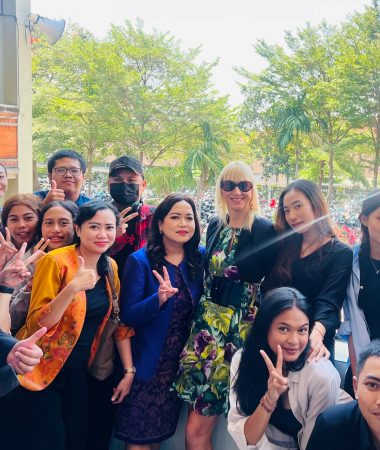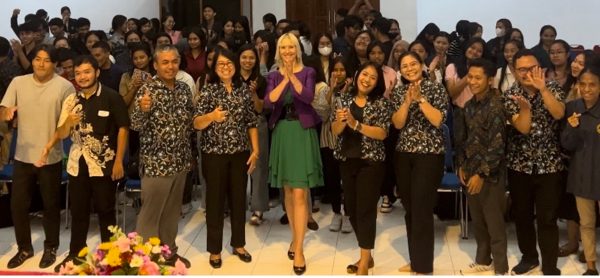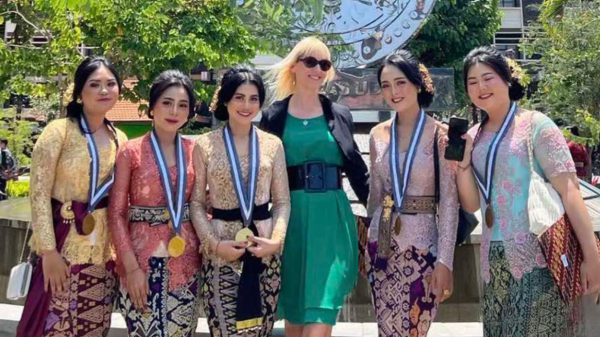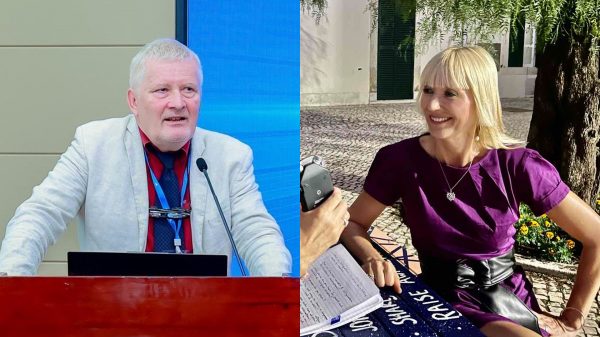
21.02.24
‘I feel a loss in myself’:
Can the loss of mother tongues in Indonesia be prevented?
By Dina Mehmedbegovic-Smith
Image above: With the graduates at University of Udayana

Image above: With the dean, colleagues and students at University of Mahasaraswati
Indonesia, one of the riches countries in the world in terms of linguistic diversity, seems to be currently at a critical moment. According to the World Economic Forum Indonesia is one of the most multilingual countries in the world. With 711 officially registered languages it takes a proud second place as a cradle of linguistic and cultural diversity (These countries have the highest linguistic diversity in the world | World Economic Forum (weforum.org)). As Ewing (2014) puts it: ‘10% of the world languages are spoken in a country that includes only 3.5% of the world population’. Not so long ago, in the 20th century, Indonesia was even more diverse with over 1000 languages, but according to the researchers following the decline of linguistic diversity in Indonesia predictions are that in the course of next 100 years only 50 Indonesian language will survive (Chon and Abtahian, 2017) Multamia (2015) reported nearly 10 years ago on 25 languages in Indonesia which were on the verge of extinction an she also identified languages which have become dormant meaning: ‘’The languages still exist but they are not used for daily communication. They no longer have speakers, but they are still used as identities of the people and for traditional ceremonies.’’ The following languages were listed as dormant: Dusner, Iha, Javindo, Kayeli, Nusa Laut, Onin and Tandia.
A week-long consultation, which I conducted in October 2023, with students and academics at four prominent Balinese universities: University of Udayana, University of Warmadewa, University of Dhyana Pura, and University of Mahasaraswati, has shed light that Balinese is another regional language heading towards becoming a dormant language. In the consultations conducted the students reflected on their experiences of grappling with the diminishing use of Balinese in their daily lives. One student’s reflection encapsulated the heart of the issue by saying: “I feel a loss in myself.” While pursuing a degree in English, she expressed the emotional toll of witnessing her proficiency in Balinese diminishing. Unable to articulate her thoughts in Balinese, she reports often resorting to Indonesian or English, leaving her with a sense of loss with a profound connection to her cultural identity. Her sentiment resonates among her peers, who share concerns about losing their Balinese heritage.
David Crystal (2002) one of the lead linguists focusing on language loss and language death provided estimates that 90% of 7000 world languages are endangered and that a language is lost every two weeks. These estimates may seem to be difficult to comprehend, but what we are seeing on the example of Indonesia with a projection of only 50 languages surviving into the next century (Cohn and Abtahian, 2017) means that Indonesia in on course to suffer the loss of over 90% of its languages. It means that what is currently happening in Indonesia is a one country example of Crystal’s global projections. This parallel makes researching and preventing language loss and language death in Indonesia of global importance. Collins (2022) writes about language death in Indonesia as a ‘sociocultural pandemic’ – which from the insights gained in Bali is happening very forcefully and silently, with the contribution of parents and educators who report that all children know that it is not important what grades they get in Balinese, which is taught one lesson a week in primary education. ‘It does not matter if you fail in Balinese, Balinese is not important in school.’ – I’ve been told by all the students I consulted.

Image above: With the colleague and students at University of Warmadewa
The researchers who have been exploring the factors which impact on language loss and death in Indonesia report that what matters most is not the number of speakers (a variable playing an unquestioned central role in many discussions about language loss), but the lack of intergenerational transmission, parents not teaching their children the regional language, focusing instead on Bahasa Indonesia and English. Even linguists and educators are not passing on their regional language to their own children, as reported by Cohn (ibid) and confirmed in my own consultations by a colleague, a linguist, who said that her children try to speak to her in Balinese sometimes, but she finds it very funny and laughs, because of their pronunciation. This shows that working on awareness of the value of regional languages, role of parents and educators in including Balinese in teaching, learning and everyday activities is of crucial importance to stop its decline.
I am currently working on searching for possible funding routes which would facilitate developing a regional strategy for Bali based on Healthy Linguistic Diet framework in order to explore possibilities of preventing the loss of Balinese as the mother tongue of current and future generations in Bali.

Image above: With the colleagues and students at University of Dhyana Pura
References:
Cohn, A. C., & Abtahian, M. R. (2017) Big Languages aren’t (Necessarily) Safe: Language Shift in the Major Languages of Indonesia. In International Seminar on Sociolinguistics and Dialectology (pp. 1-7).
Collins, J. T. (2022) Language Death in Indonesia: A Sociocultural Pandemic. Linguistik Indonesia, 40(2), 141–164.
Crystal, D. (2002) Language Death. Cambridge University Press.
Ewing, M. C. (2014) Language endangerment in Indonesia. International Journal of Education, 8(1), 12-22.
Multamia R.M.T.L. 25 Local Languages in Indonesia Almost Extinct, Expert says – Life En.tempo.co
World Economic Forum. (2023, April 27) The world’s most multilingual countries. World Economic Forum.
https://www.weforum.org/agenda/2023/04/worlds-most-multilingualcountries
About the author
https://ecspm.org/wp-content/uploads/2018/12/Rethinking-Language-Education.pdf
Dina’s work on using autobiographical multimedia classroom approaches to develop intercultural competencies has been published and recognised as good practice by the Department of Education, NALDIC (National Association for Language Development in the Curriculum) and the British Council.

